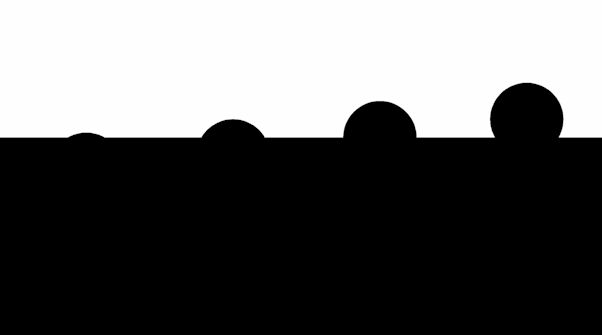|
January 2009 |
||
| New Product Announcement: Fixed Drop Calibration Reference Tool | ||
|
For many years, ramé-hart has offered a fixed drop calibration tool with 30° and 60° fixed drops. This reference tool was invaluable for ensuring the integrity of any ramé-hart goniometer - assuring the user that the instrument is calibrated and is capable of taking valid measurements. One of the drawbacks to the legacy tool is that the drop and the baseline were at slightly different planes. Thus it was possible to focus on the drop or the baseline but not both exactly at the same time. We have overcome this minor issue by making the drop and the baseline coplanar. In addition, we've added two more drops for a total of four: 30°, 60°, 90°, and 120°, as shown below, which provides a wider spectrum between low and high contact angles for replicating hydrophobic as well as hydrophilic surface conditions. We're happy to announce the debut of the new Fixed Drop Calibration Reference Tool (p/n 100-27-03). Each tool is serialized and includes a Calibration Report and Instructions for Use. This tool does not replace the Precision Combo Calibration Device which is included with each F1 Series Goniometer and is required to calibrate DROPimage; rather, the new tool is optional and is designed to be used for reference only - to help ensure that your system is properly calibrated. While this tool is optimized for the F1 Series systems, it can also be used with any legacy ramé-hart goniometer. This new tool can be purchased on our website www.ramehartstore.com or direct from our sales office. Please contact us if you are interested in purchasing one or if you have any questions about this new product.
|
||
| The Four Hottest Trends in Interface Science | ||
|
Based on the products that are selling,
the applications that we are helping our customers and potential
customers with, and the feedback we get, we've compiled for the new year
a list of the four hottest trends in Interface Science: 1. Superhydrophobicity. There were 73 articles published in the past year in Langmuir alone that specifically address this topic. Many researchers are trying to better understand the Lotus effect in an effort to replicate nature's own superhydrophobic surfaces. (See our April 2008 Newsletter.) If super isn't enough, we're now finding "Ultrahydrophobicity" creeping into the lexicon - generally ultra requires contact angles in excess of 170°. A number of new methods are being tested that use plasma treatments, particle deposition, and chemical bath treatments. 2. Nanostructured and Micropatterned Surfaces. Closely tied to superhydrophobicity, nanostructured and microstructured surfaces have become of increased interest in the past couple of years. Recently a nanopin film has been developed which results in contact angles of 178°. Other nanosurfaces include nanorod arrays, nanotubes, nanowire and nanostructure films, and nanoparticle-textured surfaces. No study of nanosurfaces and their creation can be discussed without addressing the impact of Cassie and Wenzel (see our Sept 2008 Newsletter). Researchers are working on exciting new methods for producing Lotus-like engineered surfaces with superhydrophobic properties. 3. Advancing and Receding Contact Angles. Over the past few years, a resurgent interest has arisen in dynamic advancing and receding contact angles, the contact angle hysteresis, and the roll-off angle. (See our Feb 2008 Newsletter for more on this topic.) Particularly interesting is the drop adhesion properties (sticky or slippery) and sliding behavior of drops on superhydrophobic surfaces. Contact angle defines wettability while advancing and receding angles and roll-off quantify adhesion. The "Petal Effect" is defined as a superhydrophobic surface with high adhesive force. Our Automated Tilting Base option which is used in these types of studies has been one of our best selling options in 2008.
4. Surface Dilatational Elasticity.
Although less pronounced than the above trends, there appears to be an
uptick in interest in surface dilatational rheology. (See our
Nov and
Dec 2008 Newsletters.) The axisymmetric drop and bubble shape
methods are used in conjunction with precisely controlled periodic
oscillatory deformation in order to measure surface dilatational
elasticity and viscosity. Particular interest has been placed on foam
studies, surfactant mixtures, milk and food components, and soy
globulins. |
||
| New Price List | ||
|
On January 1 of each year, we update our price list and publish it. We try to hold the line but are often required to increase prices in order to compensate for increased design, development, production, and marketing costs. We are pleased to announce that this year we did not raise one price. In fact, due to lower production costs, we've actually lowered the prices of several of our more popular accessories between 5 and 10%. We understand that during these times of economic uncertainty, it's important to do everything possible to delivery a quality product on time and at a competitive and fair price. If you would like a copy of our new 2009 published price list, please contact us. |
||
|
||


